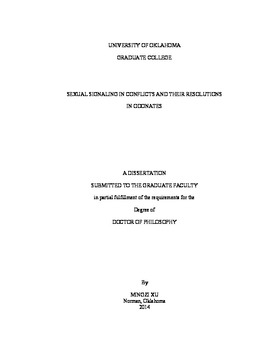| dc.description.abstract | Nature abounds with conflicts and searching for the best solution to conflicts is of interest to all animals. Among various means to resolve conflicts, signaling may be superior because it can potentially settle conflicts without risk of injury and cost of time and energy associated with physical fights or wars of attritions. In this dissertation, I seek answers to the question, can signaling help animals resolve conflicts, in two different systems.
In nature, the relationship between the two sexes is often far from harmonious. The damselfly Enallagma hageni is a species whose males frequently harass females. Males of this species are bright blue, whereas females can be either male-like blue or green. In Chapter 1, I tested for the first time, the hypothesis that female-specific color polymorphism in odonates can resolve sexual conflict by lowering male harassment towards females. Under conditions controlling for sex ratio, population density and morph frequency, I also tested two major hypotheses for the maintenance of the polymorphism. Contrary to the prediction, per capita harassment rate for the female-monomorphic treatments did not differ from that of the female-polymorphic treatments. At a male biased sex ratio, per capita harassment rate towards blue, but not green females increased with morph frequency, providing partial support for frequency-dependent selection that maintains female polymorphism.
Paradoxically, male E. hageni were obeserved to sexually harass not only females, but also other males. In Chapter 2, using E. hageni as a model system, I tested hypotheses on the causes of male-male harassment and investigated the effect of male-male harassment on male-female mating opportunity in two experiments in outdoor enclosures. Results from both experiments suggested that male mating harassment towards males had mixed causes: under male-biased sex ratios, male-male clasps may be the result of generalization from the search image of blue females to males, but under equal or female-biased sex ratios, male-male clasps may be mistakes in sexual recognition. The latter type was rare and did not incur short-term cost in male-female mating opportunities.
Discriminating between the sexes is one of the most fundamental tasks in an animal’s life, yet such discrimination can be challenging if one sex resembles the other. In Chapter 3, I investigated how male E. hageni distinguish sex when the blue females mimic male coloration. I hypothesized that males should minimize confusion by using non-mimetic cues that differ between the models (i.e., males) and the mimics (i.e., the blue females). Both female morphs share an abdominal pattern that differs from the males’. In an experiment where I modified abdominal patterns of males and females of two color morphs, I found that males selectively use both color and pattern in sex recognition: they use pattern only when they encountered blue, but nor green individuals. I then derived and tested potential male decision rules for sex recognition by exposing focal males to females painted with novel orange and pink colors. Males reacted sexually to orange- and pink-painted individuals regardless of their abdominal pattern. Collectively, the results supported a male discrimination rule of ‘if not blue, then female’, providing insights into the origin of phenotypic novelty in color polymorphic species.
In nature, females are often the limiting sex in reproduction, giving rise to intrasexual conflicts among males over reproductive resources. In the next two chapters, in a Neotropical giant damselfly Megaloprepus caerulaus, whose males defend water-filled tree holes to attract mates, I investigated whether signaling can help males resolve territorial conflicts. In Chapter 4, I investigated whether males use information from UV reflectance of a male-specific, white wing band to resolve territorial contests. I staged contests between size- and age-matched, control and UV-reduced males at natural territories. Results showed that males whose UV reflectance of the white wing bands was reduced were more likely to lose contests during early dry season.
However, a challenge to the use of signaling in resolving conflicts is that contestants may signal dishonestly. In Chapter 5, I conducted a split-family rearing experiment to investigate the honesty of the male white wing band and mechanisms maintaining honesty. I proposed that honest signals should show three features of heightened condition dependence: heightened sensitivity to nutrition, steeper isometric slope, and greater variation compared to control traits. Additionally, I hypothesized that the honesty of the male white band is maintained by negative condition-dependent cost of cheating. The male white wing band indeed showed all three features of honest signals. Further, although males in poor condition had disproportionally smaller and less bright white bands, they invested a greater proportion of their total fat to develop the signal. As a result, as predicted, cost of cheating was negative condition dependent because the deduction in fat reserve in order to exaggerate the signal would represent a greater physiological cost for males in poor condition, constraining males in poor condition from cheating. | en_US |
